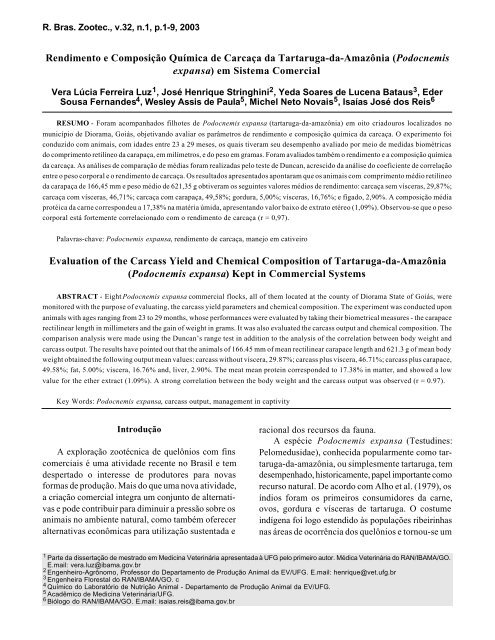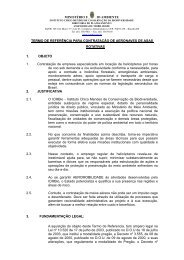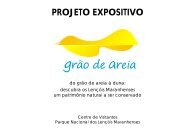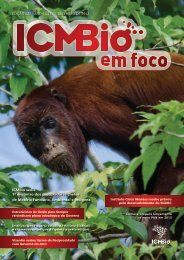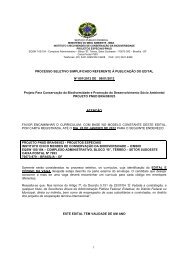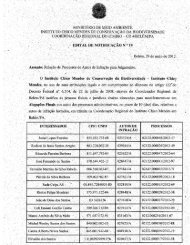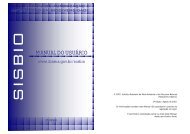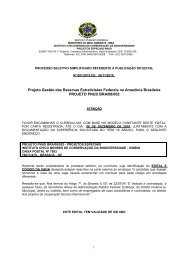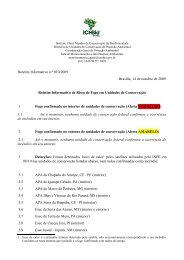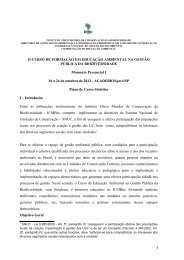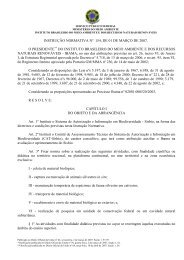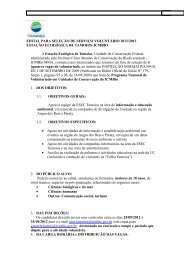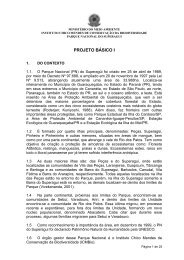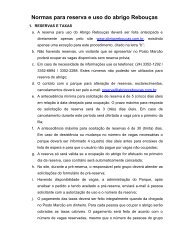Rendimento e Composição Química de Carcaça da ... - ICMBio
Rendimento e Composição Química de Carcaça da ... - ICMBio
Rendimento e Composição Química de Carcaça da ... - ICMBio
Create successful ePaper yourself
Turn your PDF publications into a flip-book with our unique Google optimized e-Paper software.
R. Bras. Zootec., v.32, n.1, p.1-9, 2003<br />
<strong>Rendimento</strong> e <strong>Composição</strong> <strong>Química</strong> <strong>de</strong> <strong>Carcaça</strong> <strong>da</strong> Tartaruga-<strong>da</strong>-Amazônia (Podocnemis<br />
expansa) em Sistema Comercial<br />
Vera Lúcia Ferreira Luz 1 , José Henrique Stringhini 2 , Ye<strong>da</strong> Soares <strong>de</strong> Lucena Bataus 3 , E<strong>de</strong>r<br />
Sousa Fernan<strong>de</strong>s 4 , Wesley Assis <strong>de</strong> Paula 5 , Michel Neto Novais 5 , Isaías José dos Reis 6<br />
RESUMO - Foram acompanhados filhotes <strong>de</strong> Podocnemis expansa (tartaruga-<strong>da</strong>-amazônia) em oito criadouros localizados no<br />
município <strong>de</strong> Diorama, Goiás, objetivando avaliar os parâmetros <strong>de</strong> rendimento e composição química <strong>da</strong> carcaça. O experimento foi<br />
conduzido com animais, com i<strong>da</strong><strong>de</strong>s entre 23 a 29 meses, os quais tiveram seu <strong>de</strong>sempenho avaliado por meio <strong>de</strong> medi<strong>da</strong>s biométricas<br />
do comprimento retilíneo <strong>da</strong> carapaça, em milímetros, e do peso em gramas. Foram avaliados também o rendimento e a composição química<br />
<strong>da</strong> carcaça. As análises <strong>de</strong> comparação <strong>de</strong> médias foram realiza<strong>da</strong>s pelo teste <strong>de</strong> Duncan, acrescido <strong>da</strong> análise do coeficiente <strong>de</strong> correlação<br />
entre o peso corporal e o rendimento <strong>de</strong> carcaça. Os resultados apresentados apontaram que os animais com comprimento médio retilíneo<br />
<strong>da</strong> carapaça <strong>de</strong> 166,45 mm e peso médio <strong>de</strong> 621,35 g obtiveram os seguintes valores médios <strong>de</strong> rendimento: carcaça sem vísceras, 29,87%;<br />
carcaça com vísceras, 46,71%; carcaça com carapaça, 49,58%; gordura, 5,00%; vísceras, 16,76%; e fígado, 2,90%. A composição média<br />
protéica <strong>da</strong> carne correspon<strong>de</strong>u a 17,38% na matéria úmi<strong>da</strong>, apresentando valor baixo <strong>de</strong> extrato etéreo (1,09%). Observou-se que o peso<br />
corporal está fortemente correlacionado com o rendimento <strong>de</strong> carcaça (r = 0,97).<br />
Palavras-chave: Podocnemis expansa, rendimento <strong>de</strong> carcaça, manejo em cativeiro<br />
Evaluation of the Carcass Yield and Chemical Composition of Tartaruga-<strong>da</strong>-Amazônia<br />
(Podocnemis expansa) Kept in Commercial Systems<br />
ABSTRACT - Eight Podocnemis expansa commercial flocks, all of them located at the county of Diorama State of Goiás, were<br />
monitored with the purpose of evaluating, the carcass yield parameters and chemical composition. The experiment was conducted upon<br />
animals with ages ranging from 23 to 29 months, whose performances were evaluated by taking their biometrical measures - the carapace<br />
rectilinear length in millimeters and the gain of weight in grams. It was also evaluated the carcass output and chemical composition. The<br />
comparison analysis were ma<strong>de</strong> using the Duncan’s range test in addition to the analysis of the correlation between body weight and<br />
carcass output. The results have pointed out that the animals of 166.45 mm of mean rectilinear carapace length and 621.3 g of mean body<br />
weight obtained the following output mean values: carcass without viscera, 29.87%; carcass plus viscera, 46.71%; carcass plus carapace,<br />
49.58%; fat, 5.00%; viscera, 16.76% and, liver, 2.90%. The meat mean protein correspon<strong>de</strong>d to 17.38% in matter, and showed a low<br />
value for the ether extract (1.09%). A strong correlation between the body weight and the carcass output was observed (r = 0.97).<br />
Key Words: Podocnemis expansa, carcass output, management in captivity<br />
Introdução<br />
A exploração zootécnica <strong>de</strong> quelônios com fins<br />
comerciais é uma ativi<strong>da</strong><strong>de</strong> recente no Brasil e tem<br />
<strong>de</strong>spertado o interesse <strong>de</strong> produtores para novas<br />
formas <strong>de</strong> produção. Mais do que uma nova ativi<strong>da</strong><strong>de</strong>,<br />
a criação comercial integra um conjunto <strong>de</strong> alternativas<br />
e po<strong>de</strong> contribuir para diminuir a pressão sobre os<br />
animais no ambiente natural, como também oferecer<br />
alternativas econômicas para utilização sustenta<strong>da</strong> e<br />
racional dos recursos <strong>da</strong> fauna.<br />
A espécie Podocnemis expansa (Testudines:<br />
Pelomedusi<strong>da</strong>e), conheci<strong>da</strong> popularmente como tartaruga-<strong>da</strong>-amazônia,<br />
ou simplesmente tartaruga, tem<br />
<strong>de</strong>sempenhado, historicamente, papel importante como<br />
recurso natural. De acordo com Alho et al. (1979), os<br />
índios foram os primeiros consumidores <strong>da</strong> carne,<br />
ovos, gordura e vísceras <strong>de</strong> tartaruga. O costume<br />
indígena foi logo estendido às populações ribeirinhas<br />
nas áreas <strong>de</strong> ocorrência dos quelônios e tornou-se um<br />
1 Parte <strong>da</strong> dissertação <strong>de</strong> mestrado em Medicina Veterinária apresenta<strong>da</strong> à UFG pelo primeiro autor. Médica Veterinária do RAN/IBAMA/GO.<br />
E.mail: vera.luz@ibama.gov.br<br />
2 Engenheiro-Agrônomo, Professor do Departamento <strong>de</strong> Produção Animal <strong>da</strong> EV/UFG. E.mail: henrique@vet.ufg.br<br />
3 Engenheira Florestal do RAN/IBAMA/GO. c<br />
4 Químico do Laboratório <strong>de</strong> Nutrição Animal - Departamento <strong>de</strong> Produção Animal <strong>da</strong> EV/UFG.<br />
5 Acadêmico <strong>de</strong> Medicina Veterinária/UFG.<br />
6 Biólogo do RAN/IBAMA/GO. E.mail: isaias.reis@ibama.gov.br
2<br />
LUZ et al.<br />
hábito alimentar <strong>da</strong> população, muitas vezes força<strong>da</strong><br />
a procurar as ativi<strong>da</strong><strong>de</strong>s extrativistas para sobreviver.<br />
A caça, que antes era apenas para consumo<br />
próprio, agora é dividi<strong>da</strong> entre a família e o comércio<br />
nas ci<strong>da</strong><strong>de</strong>s (Silva et al., 1997).<br />
O interesse na criação comercial <strong>da</strong> tartaruga-<strong>da</strong>amazônia<br />
já vem <strong>de</strong>s<strong>de</strong> os anos setenta, e o principal<br />
avanço nesse sentido <strong>de</strong>u-se com a legislação específica<br />
para a criação e a comercialização <strong>de</strong>ste quelônio<br />
(Brasil, 1993; Brasil, 1996). Desse modo, 10% dos<br />
filhotes produzidos em áreas naturais <strong>de</strong> <strong>de</strong>sovas foram<br />
disponibilizados para a criação em cativeiro e a<br />
comercialização somente po<strong>de</strong> ser efetua<strong>da</strong> com animais<br />
a partir <strong>de</strong> 1,50 kg <strong>de</strong> peso vivo. Isso propiciou um<br />
incremento no número <strong>de</strong> criadouros e fez com que<br />
essa espécie passasse a figurar no cenário econômico<br />
<strong>da</strong> Região Norte, superando o número <strong>de</strong> criadouros <strong>de</strong><br />
outras espécies silvestres (Cantarelli, 1999).<br />
Conforme Lima (1998), a escassez <strong>de</strong> informações<br />
científicas sobre a tartaruga-<strong>da</strong>-amazônia dificulta<br />
seu cultivo em escala comercial para abastecer a<br />
<strong>de</strong>man<strong>da</strong> <strong>de</strong> sua carne, muito aprecia<strong>da</strong> nos centros<br />
urbanos do Amazonas. Já existem em Manaus-AM<br />
restaurantes cre<strong>de</strong>nciados pelo Ibama para servirem<br />
pratos à base <strong>de</strong> tartaruga, e o sucesso <strong>de</strong>ssa ativi<strong>da</strong><strong>de</strong><br />
po<strong>de</strong> ser geradora <strong>de</strong> emprego para o homem rural.<br />
De acordo com Silva Neto (1998), os resultados <strong>da</strong><br />
avaliação do rendimento <strong>de</strong> carcaça <strong>de</strong> 71 espécimes <strong>de</strong><br />
P. expansa com peso médio <strong>de</strong> 2,53 kg para abate<br />
comercial apresentaram os seguintes valores porcentuais:<br />
carcaça (carne com o tecido ósseo dos membros), 30,44<br />
± 5,10%; comercial (carcaça, carapaça, gordura, fígado<br />
e coração), 56,02 ± 8,61%; carapaça, 20,68 ± 1,05% e<br />
gordura 8,20% ± 3,19. Para o autor citado, é enfatiza<strong>da</strong><br />
a importância <strong>de</strong> se comercializar o produto com a<br />
carapaça acompanhando a carcaça, visando melhor<br />
controle <strong>de</strong> sua procedência. Além disso, existe a<br />
dificul<strong>da</strong><strong>de</strong> <strong>de</strong> separar essas duas peças, pois a coluna<br />
vertebral é fundi<strong>da</strong> à carapaça.<br />
Em análises <strong>de</strong> rendimento <strong>de</strong> carcaça em cinco<br />
espécimes <strong>de</strong> P. expansa, Duarte (1998) constatou<br />
os seguintes valores porcentuais em relação ao peso<br />
corporal médio <strong>de</strong> 2,66 kg: para carcaça (dianteiro,<br />
traseiro e lombo), 32,83 ± 9,09%; para vísceras totais,<br />
7,96 ± 1,31% e para o fígado, 1,48 ± 0,29%. Esse<br />
autor informou que animais <strong>de</strong> maior tamanho e peso<br />
apresentam maior rendimento <strong>de</strong> carcaça do que<br />
animais <strong>de</strong> categorias menores.<br />
Pádua et al. (1983) proce<strong>de</strong>ram à análise <strong>da</strong><br />
carne <strong>de</strong> uma tartaruga-<strong>da</strong>-amazônia <strong>de</strong> 12 kg apreendi<strong>da</strong><br />
e constataram que o teor <strong>de</strong> proteína foi <strong>de</strong><br />
84,68% na matéria seca, superior ao <strong>da</strong>s carnes <strong>de</strong><br />
diversos animais <strong>de</strong> criações tradicionais, a exemplo<br />
do frango, bovinos, suínos, ovinos ou mesmo do leite,<br />
iogurte e ovos <strong>de</strong> galinha. A concentração <strong>de</strong><br />
aminoácidos também foi analisa<strong>da</strong>, encontrando-se<br />
em 100 gramas <strong>de</strong> proteína: lisina, 7,70 g; histidina,<br />
2,21 g; arginina, 4,11 g; treonina, 3,91 g; ácido<br />
glutâmico, 16,56 g; glicina, 5,80g; valina, 6,25 g;<br />
isoleucina, 5,41 g; tirosina, 10,64 g e metionina 5,32 g.<br />
Gaspar & Rangel Filho (2000) apresentaram como<br />
composição bromatológica <strong>da</strong> carne <strong>da</strong> tartaruga<br />
78,80% <strong>de</strong> umi<strong>da</strong><strong>de</strong>, 1,83% <strong>de</strong> lipídios e 17,39% <strong>de</strong><br />
proteína bruta. Informaram, ain<strong>da</strong>, que a carne é<br />
magra e com baixo valor calórico (86,03kcal/100g).<br />
Reis & De Marco (2000) realizaram análises <strong>da</strong><br />
composição bromatológica <strong>de</strong> seis espécimes <strong>de</strong> tartaruga-<strong>da</strong>-amazônia,<br />
com pesos entre 82,00 e 637,00 g,<br />
oriundos <strong>de</strong> cativeiro. Os resultados médios encontrados<br />
foram: para a matéria seca, 34,90%; para<br />
proteína bruta, 57,80%; e para o extrato etéreo,<br />
8,80%. Esses porcentuais aumentaram proporcionalmente<br />
em relação ao peso do animal, sugerindo que<br />
po<strong>de</strong>m ocorrer variações segundo o tamanho corporal,<br />
a i<strong>da</strong><strong>de</strong> e a quali<strong>da</strong><strong>de</strong> <strong>da</strong> dieta ofereci<strong>da</strong>.<br />
O efetivo enquadramento <strong>da</strong> tartaruga-<strong>da</strong>amazônia<br />
como fonte protéica disponível comercialmente<br />
só será reali<strong>da</strong><strong>de</strong> à medi<strong>da</strong> que houver maior<br />
conhecimento científico, relacionado à sua biologia.<br />
Pouco se conhece sobre o rendimento <strong>de</strong> carcaça, o<br />
que sugere a necessi<strong>da</strong><strong>de</strong> <strong>de</strong> se conduzirem pesquisas<br />
que possam corroborar e/ou produzir novas informações<br />
visando contribuir para a criação <strong>da</strong> tartaruga<br />
em cativeiro. Assim, esse trabalho teve como<br />
objetivo avaliar o rendimento e composição <strong>de</strong> carcaça<br />
<strong>de</strong> Podocnemis expansa, com i<strong>da</strong><strong>de</strong>s entre 23 e<br />
29 meses, mantidos em criadouros comerciais.<br />
Material e Métodos<br />
O experimento foi conduzido no período <strong>de</strong> novembro<br />
<strong>de</strong> 1999 a julho <strong>de</strong> 2000, em duas etapas. A<br />
primeira foi realiza<strong>da</strong> no município <strong>de</strong> Diorama, Goiás,<br />
localizado na região oeste do Estado, on<strong>de</strong> se acompanhou<br />
o crescimento <strong>de</strong> Podocnemis expansa em<br />
oito criadouros comerciais licenciados pelo Ibama.<br />
Na segun<strong>da</strong> etapa, realizou-se a avaliação do rendimento<br />
e <strong>da</strong> composição química <strong>da</strong>s carcaças. Essa<br />
fase foi conduzi<strong>da</strong> nos Laboratórios <strong>de</strong> Medicina Veterinária<br />
Preventiva e <strong>de</strong> Nutrição Animal <strong>da</strong> Escola <strong>de</strong><br />
R. Bras. Zootec., v.32, n.1, p.1-9, 2003
<strong>Rendimento</strong> e <strong>Composição</strong> <strong>Química</strong> <strong>de</strong> <strong>Carcaça</strong> <strong>da</strong> Tartaruga-<strong>da</strong>-Amazônia (Podocnemis expansa) em ...<br />
3<br />
Veterinária <strong>da</strong> Universi<strong>da</strong><strong>de</strong> Fe<strong>de</strong>ral <strong>de</strong> Goiás.<br />
A colheita dos <strong>da</strong>dos biométricos foi conduzi<strong>da</strong><br />
no período <strong>de</strong> 15 <strong>de</strong> novembro <strong>de</strong> 1999 a 22 <strong>de</strong> maio<br />
<strong>de</strong> 2000, correspon<strong>de</strong>ndo ao intervalo entre o 23º e o<br />
29º meses <strong>de</strong> i<strong>da</strong><strong>de</strong>. Foi toma<strong>da</strong> uma amostra mensal,<br />
aleatória, <strong>de</strong> 100 animais, capturados por re<strong>de</strong> <strong>de</strong><br />
arrasto e retira<strong>da</strong>s suas medi<strong>da</strong>s biométricas. Os<br />
procedimentos para realização <strong>da</strong>s medi<strong>da</strong>s<br />
biométricas foram aqueles utilizados pelo CENAQUA<br />
(1999). Foi medido o comprimento retilíneo <strong>da</strong> carapaça<br />
em milímetros, com o auxílio <strong>de</strong> paquímetro <strong>de</strong><br />
metal, com capaci<strong>da</strong><strong>de</strong> <strong>de</strong> 200 mm, além <strong>de</strong> paquímetro<br />
<strong>de</strong> ma<strong>de</strong>ira com capaci<strong>da</strong><strong>de</strong> <strong>de</strong> 50 cm e precisão <strong>de</strong><br />
1 cm, conforme o estágio <strong>de</strong> crescimento do animal.<br />
As medi<strong>da</strong>s foram toma<strong>da</strong>s entre a extremi<strong>da</strong><strong>de</strong><br />
anterior do contato dos primeiros escudos marginais<br />
até o ponto mais posterior <strong>da</strong> sutura dos escudos<br />
supracau<strong>da</strong>is (Figura 1). O peso foi obtido utilizandose<br />
balança eletrônica com capaci<strong>da</strong><strong>de</strong> <strong>de</strong> 3 kg e<br />
precisão <strong>de</strong> 1 g, e calcularam-se o ganho <strong>de</strong> peso e<br />
comprimento <strong>da</strong> carapaça, nos diferentes períodos.<br />
Para obtenção dos <strong>da</strong>dos e cálculos do rendimento<br />
<strong>de</strong> carcaça, foram seleciona<strong>da</strong>s cinco tartarugas, <strong>de</strong><br />
ca<strong>da</strong> criadouro, com pesos próximos aos valores médios<br />
registrados nas biometrias do 23º, 25º, 27º e 29º<br />
mês <strong>de</strong> i<strong>da</strong><strong>de</strong>, perfazendo um total <strong>de</strong> quatro colheitas<br />
com 20 exemplares <strong>de</strong> ca<strong>da</strong> criadouro. Proce<strong>de</strong>u-se à<br />
pesagem dos animais e mediu-se o comprimento<br />
retilíneo <strong>da</strong> carapaça, em milímetros. Em segui<strong>da</strong> eles<br />
foram i<strong>de</strong>ntificados e transportados para o Departamento<br />
<strong>de</strong> Medicina Veterinária Preventiva <strong>da</strong> Escola<br />
<strong>de</strong> Veterinária <strong>da</strong> UFG (Goiânia – GO), visando ao<br />
abate e à avaliação do rendimento <strong>de</strong> carcaça.<br />
O abate foi realizado conforme os procedimentos<br />
sugeridos por Silva Neto (1998). Para insensibilização<br />
dos animais, estes foram colocados em um recipiente,<br />
contendo água e gelo a uma temperatura em torno <strong>de</strong><br />
5ºC, durante 20 minutos. Para o abate foi realiza<strong>da</strong> a<br />
secção <strong>da</strong> cabeça. Após a retira<strong>da</strong> do plastrão com o<br />
auxílio <strong>de</strong> uma serra giratória elétrica, foi efetua<strong>da</strong><br />
manualmente a retira<strong>da</strong> <strong>da</strong>s vísceras do trato digestório,<br />
fígado, pâncreas, gordura, baço, pulmões, aparelho<br />
excretor, órgãos reprodutores, carcaça e o conjunto<br />
carapaça + carcaça. A carcaça compreen<strong>de</strong> to<strong>da</strong> a<br />
musculatura estria<strong>da</strong> esquelética, juntamente com o<br />
tecido ósseo dos membros e <strong>da</strong>s vértebras cervicais,<br />
lombares e cau<strong>da</strong>is, não sendo retira<strong>da</strong> a pele <strong>da</strong>s<br />
patas. A carapaça + carcaça correspon<strong>de</strong> ao conjunto<br />
comercial para a comercialização sugerido por Silva<br />
Neto (1998), <strong>de</strong>vido à dificul<strong>da</strong><strong>de</strong> <strong>de</strong> separar essas<br />
Figura 1 - Representação <strong>da</strong> medi<strong>da</strong> biométrica do comprimento<br />
retilíneo <strong>da</strong> carapaça em Podocnemis<br />
expansa (tartaruga-<strong>da</strong>-amazônia).<br />
Figure 1 - Rectilinear biometric measure of the carapace<br />
length of Podocnemis expansa (tartaruga-<strong>da</strong>amazônia).<br />
duas peças, e para controle <strong>da</strong> origem do produto.<br />
Para o cálculo <strong>de</strong> rendimento <strong>de</strong> carcaça e dos<br />
órgãos, tomou-se como base o peso vivo individual <strong>de</strong><br />
cinco tartarugas, em ca<strong>da</strong> i<strong>da</strong><strong>de</strong> estu<strong>da</strong><strong>da</strong>. As variáveis<br />
foram analisa<strong>da</strong>s para ca<strong>da</strong> i<strong>da</strong><strong>de</strong>, e os valores<br />
obtidos foram tabulados e apresentados em porcentagem:<br />
peso <strong>da</strong> carcaça com vísceras (coração, fígado,<br />
baço, pulmões, trato digestório, aparelho excretor<br />
e órgãos reprodutores); peso <strong>da</strong> carcaça sem vísceras;<br />
peso total <strong>da</strong>s vísceras (coração, fígado, baço, pulmões,<br />
trato digestório, aparelho excretor e órgãos<br />
reprodutores); peso <strong>da</strong> gordura e peso do fígado.<br />
Ao final do experimento, as carcaças <strong>de</strong> ca<strong>da</strong><br />
animal obti<strong>da</strong>s no 29º mês, por criadouro, foram<br />
i<strong>de</strong>ntifica<strong>da</strong>s e acondiciona<strong>da</strong>s em sacos plásticos e<br />
congela<strong>da</strong>s para posterior processamento. Após serem<br />
retira<strong>da</strong>s <strong>da</strong> câmara fria e <strong>de</strong>scongela<strong>da</strong>s, as<br />
carcaças foram tritura<strong>da</strong>s individualmente, utilizan-<br />
R. Bras. Zootec., v.32, n.1, p.1-9, 2003
4<br />
LUZ et al.<br />
do-se moedor <strong>de</strong> carne e, após a homogeneização, foi<br />
toma<strong>da</strong> uma alíquota em torno <strong>de</strong> 80% do peso, para<br />
ca<strong>da</strong> amostra, para utilização nas análises <strong>de</strong> proteína<br />
bruta (PB), extrato etéreo (EE) e matéria seca<br />
(MS). Para tanto, seguiram-se as metodologias analíticas<br />
propostas por Silva (1990). As análises foram<br />
realiza<strong>da</strong>s em triplicata, para ca<strong>da</strong> amostra, no Laboratório<br />
<strong>de</strong> Nutrição Animal do Departamento <strong>de</strong><br />
Produção Animal <strong>da</strong> Escola <strong>de</strong> Veterinária <strong>da</strong> UFG,<br />
em Goiânia. A proteína bruta e o extrato etéreo<br />
foram calculados com base na matéria úmi<strong>da</strong> (MN)<br />
e na matéria seca (MS) a 105ºC. Foi calcula<strong>da</strong><br />
também a relação entre proteína bruta e o extrato<br />
etéreo com base na matéria úmi<strong>da</strong>.<br />
As análises estatísticas foram realiza<strong>da</strong>s <strong>de</strong> acordo<br />
com o recomen<strong>da</strong>do por Sampaio (1998), utilizando-se<br />
o programa ESTAT (Sistema <strong>de</strong> Análises Estatísticas)<br />
<strong>de</strong>senvolvido pelo Departamento <strong>de</strong> Ciências<br />
Exatas <strong>da</strong> Universi<strong>da</strong><strong>de</strong> Estadual Paulista/Facul<strong>da</strong><strong>de</strong><br />
<strong>de</strong> Ciências Agrárias e Veterinárias, Campus <strong>de</strong><br />
Jaboticabal. Foi aplicado o teste Duncan, a 5% <strong>de</strong><br />
probabili<strong>da</strong><strong>de</strong>, para comparação <strong>de</strong> médias. Para tanto,<br />
os <strong>da</strong>dos porcentuais <strong>de</strong> carcaça com vísceras, carcaça<br />
sem vísceras, carapaça + carcaça, gordura e fígado<br />
foram transformados em arco seno vx.<br />
Objetivando verificar a potência <strong>da</strong>s relações entre<br />
o peso médio corporal e o peso dos diversos <strong>da</strong>dos<br />
<strong>de</strong> rendimento <strong>da</strong> carcaça, foram analisa<strong>da</strong>s as correlações<br />
<strong>de</strong>ssas variáveis por meio <strong>de</strong> análise <strong>de</strong> regressão<br />
múltipla. Para esses cálculos foram utilizados os<br />
valores médios dos pesos no período <strong>de</strong> 23 a 29 meses,<br />
no programa computacional Statistica (Stat Soft, 1996).<br />
Resultados e Discussão<br />
Analisados os valores médios <strong>de</strong> rendimento <strong>de</strong><br />
carcaça com vísceras, sem vísceras e o conjunto<br />
comercial (carapaça + carcaça) nos oito criadouros,<br />
entre 23 e 29 meses <strong>de</strong> i<strong>da</strong><strong>de</strong> (Tabelas 1 e 2),<br />
comparados pelo teste Duncan, observou-se diferen-<br />
Tabela 1 - Valores médios <strong>de</strong> rendimento <strong>da</strong> carcaça com e sem vísceras <strong>de</strong> Podocnemis expansa com i<strong>da</strong><strong>de</strong> entre 23<br />
e 29 meses, provenientes <strong>de</strong> criadouros comerciais (n = 5)<br />
Table 1 - Mean carcass yield values for carcass with and without viscera of Podocnemis expansa from 23 to 29 months of age, from<br />
commercial flocks (n = 5)<br />
Criadouros<br />
Commercial flocks<br />
R. Bras. Zootec., v.32, n.1, p.1-9, 2003<br />
I<strong>da</strong><strong>de</strong> (meses)<br />
Age (months)<br />
23 25 27 29<br />
<strong>Rendimento</strong> <strong>da</strong> carcaça com vísceras (%)<br />
Yield of the carcass plus viscera (%)<br />
Faz. Vale <strong>da</strong> Serra 44,93 b 48,40 ab 49,86 ab 53,02 a<br />
Pró-Fauna 49,04 b 48,21 ab 53,38 a 51,87 ab<br />
Agrotec 51,10 a 49,92 a 48,39 ab 48,08 bc<br />
Faz. São Romão 43,45 b 48,92 ab 39,66 c 46,45 c<br />
Faz. Campo Redondo 46,36 b 48,12 ab 52,48 a 49,11 abc<br />
Faz. Lambari 48,28 b 46,24 b 48,87 ab 46,75 c<br />
Faz. Rios dos Bois 45,78 b 40,89 c 46,59 b 40,86 d<br />
Faz. Alcantilhado 42,55 b 46,39 b 38,79 c 37,54 d<br />
Média (Mean) 46,44 47,13 47,18 46,71<br />
CV (%) 5,90 2,78 4,36 4,71<br />
<strong>Rendimento</strong> <strong>da</strong> carcaça sem vísceras (%)<br />
Yield of the carcass without viscera (%)<br />
Faz. Vale <strong>da</strong> Serra 30,40 a 30,80 a 33,92 a 36,26 a<br />
Pró-Fauna 30,96 a 30,01 ab 32,60 ab 36,99 a<br />
Agrotec 30,96 a 29,98 ab 30,41 b 30,39 c<br />
Faz. São Romão 30,23 a 28,07 bc 26,54 c 27,34 d<br />
Faz. Campo Redondo 29,10 ab 27,17 c 31,10 b 35,43 ab<br />
Faz. Lambari 29,53 a 28,84 abc 31,09 b 32,76 bc<br />
Faz. Rios dos Bois 26,22 b 24,31 d 26,25 c 26,96 d<br />
Faz. Alcantilhado 28,95 ab 28,30 abc 27,97 c 26,71 d<br />
Média (Mean) 29,55 28,44 29,89 31,60<br />
CV (%) 4,17 3,45 3,17 4,01<br />
Médias segui<strong>da</strong>s por letras iguais, na mesma coluna, não diferem entre si pelo teste Duncan (P>0,05); CV = coeficiente <strong>de</strong> variação.<br />
Means indicated by the same letters, in the same column, do not differ by Duncan range test (P>.05); CV = coefficient of variation.
<strong>Rendimento</strong> e <strong>Composição</strong> <strong>Química</strong> <strong>de</strong> <strong>Carcaça</strong> <strong>da</strong> Tartaruga-<strong>da</strong>-Amazônia (Podocnemis expansa) em ...<br />
5<br />
Tabela 2 - Valores médios <strong>de</strong> rendimento do conjunto comercial (carapaça + carcaça), <strong>de</strong> Podocnemis expansa, entre<br />
23 e 29 meses <strong>de</strong> i<strong>da</strong><strong>de</strong>, provenientes <strong>de</strong> criadouros comerciais (n = 5)<br />
Table 2 - Mean yield values for the whole commercial stuff (carapace + carcass) of Podocnemis expansa from 23 to 29 months of<br />
age, from commercial flocks (n = 5)<br />
Criadouros<br />
Commercial flocks<br />
I<strong>da</strong><strong>de</strong> (meses)<br />
Age (months)<br />
23 25 27 29<br />
<strong>Rendimento</strong> <strong>de</strong> carcaça + carapaça<br />
Yield of the carcass + carapace<br />
Faz. Vale <strong>da</strong> Serra 57,72 a 50,22 a 53,60 a 54,90 a<br />
Pró-Fauna 55,85 a 49,22 ab 52,10 ab 56,39 a<br />
Agrotec 53,72 a 49,55 ab 48,90 bc 50,22 b<br />
Faz. São Romão 48,60 ab 45,63 c 47,93 bc 47,36 bc<br />
Faz. Campo Redondo 43,59 b 45,43 c 49,17 bc 53,63 bc<br />
Faz. Lambari 50,85 ab 47,98 b 48,87 bc 53,89 a<br />
Faz. Rios dos Bois 48,57 ab 43,05 d 45,36 c 46,40 c<br />
Faz. Alcantilhado 50,36 ab 45,70 c 47,69 c 46,65 c<br />
Média (Mean) 50,95 47,10 49,09 51,18<br />
CV (%) 6,52 2,07 3,74 3,02<br />
Médias segui<strong>da</strong>s por letras iguais, na mesma coluna, não diferem entre si pelo teste Duncan (P>0,05); CV = coeficiente <strong>de</strong> variação.<br />
Means indicated by the same letters, in the same column, do not differ by Duncan range test (P>.05); CV = coefficient of variation.<br />
ça (P
6<br />
LUZ et al.<br />
Tabela 3 - Valores médios do comprimento retilíneo <strong>da</strong> carapaça (mm) e peso corporal (g) <strong>de</strong> Podocnemis expansa com<br />
i<strong>da</strong><strong>de</strong> entre 23 e 29 meses, <strong>de</strong> criadouros comerciais (n = 100)<br />
Table 3 - Mean value rectilinear carapace length (mm) and body weight (g) of Podocnemis expansa from 23 to 29 months of age,<br />
from comercial flocks (n = 100)<br />
Criadouros<br />
Commercial flocks<br />
I<strong>da</strong><strong>de</strong> (meses)<br />
Age (months)<br />
23 25 27 29<br />
Comprimento médio <strong>da</strong> carapaça (mm)<br />
Mean rectileneal carapace lenght (mm)<br />
Faz. Vale <strong>da</strong> Serra 180,80 a 203,20 a 218,00 a 211,40 a<br />
Pró-Fauna 167,80 bc 179,40 c 191,20 b 188,00 b<br />
Agrotec 164,20 c 162,20 d 162,80 <strong>de</strong> 164,80 d<br />
Faz. São Romão 171,40 b 188,20 b 172,60 c 175,80 c<br />
Faz. Campo Redondo 146,40 e 153,60 e 159,20 ef 158,60 d<br />
Faz. Lambari 154,00 d 158,80 <strong>de</strong> 166,80 d 164,60 d<br />
Faz. Rios dos Bois 147,80 <strong>de</strong> 146,80 f 155,20 f 147,20 e<br />
Faz. Alcantilhado 128,40 f 125,60 g 124,40 g 121,20 f<br />
Média (Mean) 157,60 164,72 167,51 166,45<br />
CV (%) 3,30 2,73 2,55 2,96<br />
Peso corporal médio (g)<br />
Mean body weight (g)<br />
Faz. Vale <strong>da</strong> Serra 774,00 a 1026,00 a 1216,75 a 1195,20 a<br />
Pró-Fauna 585,40 b 742,60 b 849,00 b 799,80 b<br />
Agrotec 531,60 c 529,60 c 495,00 fg 519,20 f<br />
Faz. São Romão 609,20 b 771,20 b 590,40 e 628,20 c<br />
Faz. Campo Redondo 468,60 d 536,80 c 626,20 c 607,00 d<br />
Faz. Lambari 477,80 d 539,00 c 591,00 <strong>de</strong> 565,80 e<br />
Faz. Rios dos Bois 434,60 e 427,00 d 481,80 g 421,80 g<br />
Faz. Alcantilhado 287,60 f 264,40 e 254,40 h 233,80 h<br />
Média (Mean) 521,10 604,57 623,23 621,35<br />
CV 4,27 4,56 3,64 2,21<br />
Médias segui<strong>da</strong>s por letras iguais, na mesma coluna, não diferem entre si pelo teste Duncan (P>0,05); CV = coeficiente <strong>de</strong> variação.<br />
Means indicated by the same letters, in the same column, do not differ by Duncan range test (P>.05); CV = coefficient of variation.<br />
Tabela 4 - Porcentual <strong>da</strong> gordura em relação ao peso corporal médio <strong>de</strong> Podocnemis expansa, entre 23 e 29 meses<br />
<strong>de</strong> i<strong>da</strong><strong>de</strong>, provenientes <strong>de</strong> criadouros comerciais (n = 5)<br />
Table 4 - Fat percentage in relation to the mean body weight of Podocnemis expansa from 23 to 29 months of age, from commercial<br />
flocks (n = 5)<br />
Criadouros<br />
Commercial flocks<br />
R. Bras. Zootec., v.32, n.1, p.1-9, 2003<br />
I<strong>da</strong><strong>de</strong> (meses)<br />
Age (months)<br />
23 25 27 29<br />
Gordura (%)<br />
Fat (%)<br />
Faz. Vale <strong>da</strong> Serra 11,35 a 10,12 a 9,60 a 9,22 a<br />
Pró-Fauna 3,14 c 4,54 bc 3,21 d 4,20 bc<br />
Agrotec 4,47 bc 4,30 bc 2,29 <strong>de</strong> 3,38 c<br />
Faz. São Romão 5,49 bc 4,62 bc 0,79 e 3,02 c<br />
Faz. Campo Redondo 6,23 b 5,77 b 5,61 bc 6,08 b<br />
Faz. Lambari 4,55 bc 5,02 bc 5,85 b 6,36 b<br />
Faz. Rios dos Bois 4,35 bc 3,36 c 5,10 bc 2,25 bc<br />
Faz. Alcantilhado 6,78 b 5,43 b 3,66 cd 0,88 d<br />
Média (Mean) 5,79 5,40 4,38 4,42<br />
CV (%) 18,36 12,62 12,44 19,57<br />
Médias segui<strong>da</strong>s por letras iguais, na mesma coluna, não diferem entre si pelo teste Duncan (P>0,05); CV = coeficiente <strong>de</strong> variação.<br />
Means indicated by the same letters, in the same column, do not differ by Duncan range test (P>.05); CV = coefficient of variation.
<strong>Rendimento</strong> e <strong>Composição</strong> <strong>Química</strong> <strong>de</strong> <strong>Carcaça</strong> <strong>da</strong> Tartaruga-<strong>da</strong>-Amazônia (Podocnemis expansa) em ...<br />
7<br />
Tabela 5 - Porcentual <strong>da</strong>s vísceras totais em relação ao peso corporal médio <strong>de</strong> Podocnemis expansa, entre 23 e 29<br />
meses <strong>de</strong> i<strong>da</strong><strong>de</strong>, provenientes <strong>de</strong> criadouros comerciais (n = 5)<br />
Table 5 - Total viscera percentage in relation to the mean body weight of Podocnemis expansa from 23 to 29 months of age, from<br />
commercial flocks (n = 5)<br />
Criadouros<br />
Commercial flocks<br />
I<strong>da</strong><strong>de</strong> (meses)<br />
Age (months)<br />
23 25 27 29<br />
Vísceras (%)<br />
Viscera (%)<br />
Faz. Vale <strong>da</strong> Serra 14,53 bcd 17,59 ab 15,94 ab 16,79 abc<br />
Pró-Fauna 18,08 ab 18,18 ab 20,79 a 14,80 bc<br />
Agrotec 20,13 a 19,93 ab 17,97 a 17,68 ab<br />
Faz. São Romão 13,22 d 20,85 a 13,16 bc 19,10 a<br />
Faz. Campo Redondo 17,25 abc 21,15 a 21,38 a 13,68 cd<br />
Faz. Lambari 18,75 a 17,39 ab 17,78 a 13,98 bcd<br />
Faz. Rios dos Bois 19,55 a 16,57 b 20,34 a 13,90 bcd<br />
Faz. Alcantilhado 13,60 cd 10,59 c 10,59 c 10,82 d<br />
Média (Mean) 16,89 17,78 17,28 15,09<br />
CV (%) 9,70 7,79 9,96 9,65<br />
Médias segui<strong>da</strong>s por letras iguais, na mesma coluna, não diferem entre si pelo teste Duncan (P>0,05); CV = coeficiente <strong>de</strong> variação.<br />
Means indicated by the same letters, in the same column, do not differ by Duncan range test (P>.05); CV = coefficient of variation.<br />
criadouros (P
8<br />
LUZ et al.<br />
Tabela 6 - Percentuais dos pesos do fígado em relação ao peso corporal médio <strong>de</strong> Podocnemis expansa entre 23 e<br />
29 meses <strong>de</strong> i<strong>da</strong><strong>de</strong>, provenientes <strong>de</strong> criadouros comerciais (n = 5)<br />
Table 6 - Liver percentage weights in relation to the mean body weight of Podocnemis expansa from 23 to 29 months of age, from<br />
commercial flocks (n = 5)<br />
Criadouros<br />
Commercial flocks<br />
I<strong>da</strong><strong>de</strong> (meses)<br />
Age (months)<br />
23 25 27 29<br />
Fígado (%)<br />
Liver (%)<br />
Faz. Vale <strong>da</strong> Serra 3,09 ab 3,60 a 4,10 a 4,66 a<br />
Pró-Fauna 2,57 bcd 2,90 b 3,89 ab 4,41 a<br />
Agrotec 2,86 abc 2,85 b 3,27 cd 3,84 b<br />
Faz. São Romão 2,15 d 2,18 c 1,86 f 2,38 d<br />
Faz. Campo Redondo 2,03 d 2,63 b 2,79 e 3,91 b<br />
Faz. Lambari 2,31 cd 2,44 bc 2,83 <strong>de</strong> 3,01 c<br />
Faz. Rios dos Bois 2,28 cd 1,52 d 1,85 f 1,61 e<br />
Faz. Alcantilhado 3,49 a 3,57 a 3,58 abc 2,55 d<br />
Média (Mean) 2,60 2,71 2,99 3,30<br />
CV (%) 8,71 6,73 3,58 5,50<br />
Médias segui<strong>da</strong>s por letras iguais, na mesma coluna, não diferem entre si pelo teste Duncan (P>0,05); CV = coeficiente <strong>de</strong> variação.<br />
Means indicated by the same letters, in the same column, do not differ by Duncan range test (P>.05); CV = coefficient of variation.<br />
Tabela 7 - <strong>Composição</strong> <strong>da</strong> carcaça <strong>de</strong> Podocnemis expansa com i<strong>da</strong><strong>de</strong> entre 23 e 29 meses, provenientes <strong>de</strong> criadouros<br />
comerciais (n=5)<br />
Table 7 - Carcass composition of Podocnemis expansa from 23 to 29 months of age, from commercial flocks (n= 5)<br />
Criadouros <strong>Composição</strong> porcentual <strong>da</strong> carcaça (%)<br />
Commercial flocks Carcass percent composition (%)<br />
MS Proteína bruta Extrato etéreo PB/EE<br />
Dry mater Cru<strong>de</strong> protein Ether extract<br />
MU MS MU MS<br />
WM DM WM DM<br />
Faz. Vale <strong>da</strong> Serra 24,56 a 19,26 a 78,58 a 1,46 b 5,85 b 13,19 <strong>de</strong><br />
Pró-Fauna 22,69 c 18,15 ab 80,43 a 1,55 ab 6,68 ab 13,00 <strong>de</strong><br />
Agrotec 24,87 a 19,56 a 78,57 a 1,95 a 7,92 a 10,16 e<br />
Faz. São Romão 23,75 ab 18,29 ab 77,10 a 1,10 bcd 4,62 bc 17,03 <strong>de</strong><br />
Faz. C. Redondo 23,26 ab 18,37 ab 78,89 a 0,33 e 1,43 e 57,88 a<br />
Faz. Lambari 21,49 bc 16,37 bc 76,73 a 0,49 <strong>de</strong> 2,29 <strong>de</strong> 37,38 b<br />
Faz. R. dos Bois 20,10 c 15,62 c 77,88 a 0,74 c<strong>de</strong> 3,88 d 21,18 cd<br />
Faz. Alcantilhado 17,68 d 13,42 d 75,64 a 0,87 cd 5,05 bc 15,88 <strong>de</strong><br />
Média (Mean) 22,30 17,38 77,98 1,09 4,79 22,48<br />
CV (%) 7,62 9,09 6,44 25,86 26,02 29,41<br />
Médias segui<strong>da</strong>s por letras iguais, na mesma coluna, não diferem entre si pelo teste Duncan (P>0,05); CV = coeficiente <strong>de</strong> variação.<br />
Means indicated by the same letters, in the same column, do not differ by Duncan range test (P>.05); CV = coefficient of variation.<br />
MU = matéria úmi<strong>da</strong>; MS = matéria seca.<br />
WM = wet matter; DM = dry matter.<br />
R. Bras. Zootec., v.32, n.1, p.1-9, 2003
<strong>Rendimento</strong> e <strong>Composição</strong> <strong>Química</strong> <strong>de</strong> <strong>Carcaça</strong> <strong>da</strong> Tartaruga-<strong>da</strong>-Amazônia (Podocnemis expansa) em ...<br />
9<br />
Tabela 8 - Coeficientes <strong>de</strong> correlação (r) entre o peso corporal, o rendimento <strong>de</strong> carcaça e <strong>da</strong>dos morfométricos do trato<br />
digestivo <strong>de</strong> P. expansa entre 23 e 29 meses (n = 160)<br />
Table 8 - Correlation coefficient (r) among body weight (BW), carcass output and morphometrical <strong>da</strong>ta of the digestive tract of<br />
P. expansa from 23 to 29 months of age (n = 160)<br />
PC CAR+VISC CAR CAR+CA VISC GORD<br />
BW CAR+VISC CAR CAR+CA VISC FAT<br />
CAR+VISC (CAR+VISC) 0,97<br />
CAR (CAR) 0,97 0,97<br />
CAR+ CA (CAR+CA) 0,97 0,96 0,97<br />
VISC (VISC) 0,86 0,91 0,81 0,81<br />
GORD (FAT) 0,81 0,77 0,79 0,79 0,63<br />
PC = peso corporal; CAR +VISC= carcaça com vísceras; CAR = carcaça sem vísceras; CAR+ CA = carcaça com carapaça; VISC =<br />
vísceras; GOR = gordura.<br />
PC = body weight; CAR + VISC = carcass plus viscera; CAR = carcass without viscera; CAR + CA = carcass + carapace; VISC = viscera; FAT = total fat.<br />
Conclusões<br />
Ain<strong>da</strong> que os animais apresentem peso médio<br />
inferior ao permitido para o abate, o rendimento <strong>de</strong><br />
carcaça na or<strong>de</strong>m <strong>de</strong> 30% respon<strong>de</strong> à necessi<strong>da</strong><strong>de</strong> do<br />
mercado, pois o peso vivo <strong>de</strong> 1,50 kg confere aproxima<strong>da</strong>mente<br />
450 g <strong>de</strong> carne com ossos.<br />
A composição média do teor protéico e o baixo<br />
valor <strong>de</strong> extrato etéreo indicam bom valor nutricional<br />
<strong>da</strong> carne <strong>de</strong> tartaruga-<strong>da</strong>-amazônia.<br />
Literatura Cita<strong>da</strong><br />
ALHO, C.J.R.; CARVALHO, A.G.; PÁDUA, L.F.M. Ecologia<br />
<strong>da</strong> tartaruga-<strong>da</strong>-amazônia e avaliação <strong>de</strong> seu manejo na Reserva<br />
Biológica do Trombetas. Brasil Florestal, v.38, p.29-47,<br />
1979.<br />
ASHLEY, L.M. Laboratory anatomy of the turtle. Gainesville:<br />
WCB Brown Company Publishers, 1969. p. 18-23.<br />
BRASIL. Portaria nº 142 <strong>de</strong> 30 <strong>de</strong> <strong>de</strong>zembro <strong>de</strong> 1992. Normatiza<br />
a criação em cativeiro <strong>da</strong> tartaruga-<strong>da</strong>-amazônia,<br />
Podocnemis expansa e do tracajá Podocnemis unifilis com<br />
finali<strong>da</strong><strong>de</strong> comercial, partindo <strong>de</strong> filhotes, nas áreas <strong>de</strong><br />
distribuição geográfica. Diário Oficial [<strong>da</strong>] República Fe<strong>de</strong>rativa<br />
do Brasil. Brasília, DF, 21 jan. 1993. p 922-923.<br />
BRASIL. Portaria nº 70 <strong>de</strong> 23 <strong>de</strong> agosto <strong>de</strong> 1996. Normatiza a<br />
comercialização <strong>de</strong> produtos <strong>da</strong>s espécies <strong>de</strong> quelônios,<br />
Podocnemis expansa, tartaruga-<strong>da</strong>-amazônia, e<br />
Podocnemis unifilis, tracajá, provenientes <strong>de</strong> criadouros<br />
comerciais regulamentados pelo Ibama. Diário Oficial<br />
[<strong>da</strong>] União <strong>da</strong> República Fe<strong>de</strong>rativa do Brasil. Brasília, DF,<br />
26 ago., 1996. Seção I, p.16.390-16.391.<br />
CANTARELLI, V.H. Manejo <strong>da</strong> fauna silvestre nas reservas<br />
<strong>de</strong> fauna <strong>da</strong> Amazônia: informe Brasil. Goiânia: [s.n.],<br />
1999. 99p. Relatório.<br />
CENAQUA. Conservação e criação comercial <strong>de</strong> quelônios.<br />
Goiânia: Centro Nacional dos Quelônios <strong>da</strong> Amazônia-Ibama,<br />
1999. 34p. Mimeografado.<br />
DUARTE, F.S. Diagnóstico <strong>da</strong> criação <strong>de</strong> quelônios e incubação<br />
artificial <strong>de</strong> ovos <strong>de</strong> tartaruga Podocnemis expansa no<br />
Amazonas. Manaus: Fun<strong>da</strong>ção Universi<strong>da</strong><strong>de</strong> do Amazonas,<br />
1998. 76p. Monografia (Graduação em Engenharia<br />
Agronômica) - Fun<strong>da</strong>ção Universi<strong>da</strong><strong>de</strong> do Amazonas, 1998.<br />
GASPAR, A.; RANGEL FILHO, F.B. Utilização <strong>de</strong> carnes <strong>de</strong><br />
Tartarugas-<strong>da</strong>-amazônia, Podocnemis expansa, cria<strong>da</strong>s em<br />
cativeiros, para consumo humano. In: CONGRESSO BRA-<br />
SILEIRO DE CIÊNCIA E TECNOLOGIA DE ALIMEN-<br />
TOS, 18., 2000, Fortaleza. Resumos... Fortaleza:SBCTA,<br />
2000. resumo n.3.31. [s.p.].<br />
LIMA, M.G.H.S. A importância <strong>da</strong>s proteínas <strong>de</strong> origem<br />
animal e vegetal no primeiro ano <strong>de</strong> vi<strong>da</strong> <strong>da</strong> tartaruga<strong>da</strong>-amazônia<br />
– Podocnemis expansa (Schweigger, 1812).<br />
Manaus: Universi<strong>da</strong><strong>de</strong> do Amazonas e Instituto <strong>de</strong> Pesquisa<br />
<strong>da</strong> Amazônia, 1998. 93p. Dissertação (Mestrado em Ciência<br />
<strong>de</strong> Alimentos) - Universi<strong>da</strong><strong>de</strong> do Amazonas e Instituto <strong>de</strong><br />
Pesquisa <strong>da</strong> Amazônia, 1998.<br />
PÁDUA, L.F.M.; ALHO, C.J.R.; CARVALHO, A.G. Conservação<br />
e manejo <strong>da</strong> tartaruga-<strong>da</strong>-amazônia, Podocnemis<br />
expansa, na Reserva Biológica do Rio Trombetas (Testudines,<br />
Pelomedusi<strong>da</strong>e). Brasil Florestal, v.54, p.43-53, 1983.<br />
REIS, A.P.; DE MARCO Jr., P. Análise morfométrica <strong>de</strong> filhotes<br />
<strong>de</strong> tartaruga-<strong>da</strong>-amazônia, Podocnemis expansa (Schweigger,<br />
1812) em criatórios comerciais. In: CONGRESSO BRASI-<br />
LEIRO DE ZOOLOGIA, 23., 2000, Cuiabá. Resumos...<br />
Cuiabá: Socie<strong>da</strong><strong>de</strong> Brasileira <strong>de</strong> Zoologia/Universi<strong>da</strong><strong>de</strong> Fe<strong>de</strong>ral<br />
<strong>de</strong> Mato Grosso, 2000. p.523.<br />
ROZE, J.A. Piligrin of the river. Natural History, v.73,<br />
p.34-41, 1964.<br />
SAMPAIO, I.B.M. Estatística aplica<strong>da</strong> à experimentação<br />
animal. Belo Horizonte: Fun<strong>da</strong>ção <strong>de</strong> Ensino e Pesquisa em<br />
Medicina Veterinária e Zootecnia, Universi<strong>da</strong><strong>de</strong> Fe<strong>de</strong>ral <strong>de</strong><br />
Minas Gerais, 1998. 221p.<br />
SILVA, D.J. Análise <strong>de</strong> alimentos (métodos químicos e biológicos),<br />
2.ed. Viçosa, MG: Universi<strong>da</strong><strong>de</strong> Fe<strong>de</strong>ral <strong>de</strong> Viçosa,<br />
1990. 165p.<br />
SILVA, C.S.; MELO, D.S.; RODRIGUES, E.C.P.G. et al. Consumo<br />
<strong>de</strong> produtos <strong>da</strong> fauna silvestre na ci<strong>da</strong><strong>de</strong> <strong>de</strong> Manaus.<br />
1997. 24p. Trabalho apresentado à disciplina Conservação e<br />
Manejo <strong>de</strong> Fauna Silvestre. Facul<strong>da</strong><strong>de</strong> <strong>de</strong> Ciências Agrárias,<br />
Universi<strong>da</strong><strong>de</strong> do Amazonas, Manaus, 1997.<br />
SILVA NETO, P.B. Abate <strong>de</strong> tartarugas-<strong>da</strong>-amazônia. São<br />
Paulo: Pró-Fauna Assessoria e Comércio Lt<strong>da</strong>., Convênio<br />
Empresa Pro-Fauna/Cenaqua-Ibama, 1998. 48p. Relatório.<br />
STAT SOFT, I. Statistica for windows. Tulsa, USA, 1996.<br />
Computer program manual.<br />
Recebido em: 29/06/01<br />
Aceito em: 16/04/02<br />
R. Bras. Zootec., v.32, n.1, p.1-9, 2003


